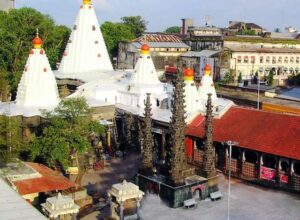
Bakreshwar town in Birbhum district of West Bengal is famous for its temple which is dedicated to lord Bakranath (Shiva) and goddess Kali.
Although Bakreshwar, is primarily renowned for its Shiva temple and therapeutic hot springs, these attractions tend to overshadow its parallel significance as a place of power for goddess devotees. As a shakti pith, the Mahishamardini Mandir draws worshipers of the divine mother to this country town, named for its resident male god. At the heart of Bakreshwar, the spiritual traditions of Shiva and Shakti converge, reconciling the dichotomy of masculine and feminine divinity in one harmonious temple complex.
Historically a focal point of religious pilgrimage, the majority of Hindus travelling to Bakreshwar come for its famous Shiva Mandir. Although the presence of a shakti pith and its corresponding mandir (Hindu temple) technically make Bakreshwar a two-temple complex, the veneration of Lord Shiva observably assumes a position of elevated prominence.
The name Bakreshwar is a compound of two words: bakra, meaning “curve” or “deformity,” and ishwar meaning “lord.” According to local legend, it was in the vicinity of the Bakreshwar Mandir that a crippled sage, named Ashtabakra (“eight curves”) Muni, intensely meditated upon Lord Shiva for 10,000 years. Profoundly moved by this ardent display of penance, Lord Shiva not only cured his beloved devotee of physical deformity, but further declared that those who visited Bakreshwar and venerated Ashtabakra before him would be graced with a surplus of boons. Corresponding with this myth, there are two lingams housed within the Shiva temple. The larger lingam is referred to as Ashtabakra, and the smaller one is called Bakreshwar. Although specified with different names, both of these lingams are perceived as physical manifestations of Lord Shiva which, by extension, function as conduits of spiritual power through which the god can be communed.
Deviating from typical Bengali style, the Bakreshwar Mandir, with its distinctive curvilinear shikhara (rising tower above the sanctum sanctorum), and the surrounding complex evince a strong Oriyan architectural influence. The inner sanctum, which houses the lingams associated with Shiva and the sage Ashtabakra, is accessed through a roofed, tunnel-like corridor.
Located close to Bakreshwar’s preeminent Shiva temple, the Mahishamardini Mandir is discernible by the bright orange shikhara towering above it. The portion between Devi Sati’s eyebrows- symbolic of her mind – is said to have fallen in this region when Lord Vishnu used his sudarshan chakra on her burnt corpse. A shrine was erected later and was consecrated to the worship of Shaivaite forces.
The name of the goddess revered here, Mahishamardini, is a well-known epithet of the goddess Durga. Within the garbhagriha of this mandir, a small shrine, carved from marble, rests atop a rectangular pedestal and houses the sacred image of Mahishamardini. This murti is a cast metal sculpture in high relief depicting the goddess, accompanied by her lion vahana (animal vehicle), thrusting a spear through the heart of the demon Mahisha.
Within the Mahishamardini Mandir, a stone formation corresponding in shape to the ornamented portion of flesh between the Mahadevi’s eyebrows, her bhru moddo, is enshrined and venerated.
Hotsprings
Bakreshwar is the site of several geothermal hot springs, some of which are believed to have healing properties. They all discharge in to a rivulet which run past and join a small stream about 200 yards from the temple.
Throughout its history, people suffering from a spectrum of afflictions have sought relief by coming here to bathe in these mineral-rich waters. Many of the smaller springs are bounded by concrete retaining walls, in a quasi-rectangular configuration resembling a stylized yoni, with descending steps on one open side permitting access to the water. The two largest stepwells are surrounded with a gated wall and function as the primary “public baths” of Bakreshwar. The unique geothermal activity not only effects the enclosed springs, but much of the water found in this area.
The main temple of Bakreswar is surrounded by many small shrines which are dedicated to Lord Shiva. The other temples here are Bhavatarini Mandir, Batuk Bhairav Mandir.
The annual mela of Bakreswar held during Sivaratri draws lakhs of devotees and turn this into Bhuloka Kailas with all kinds of devotional activities.
Source:
https://www.templepurohit.com/hindu-temple/bakreswar-temple-west-bengal/
http://www.kalibhakti.com/bakreshwar/


